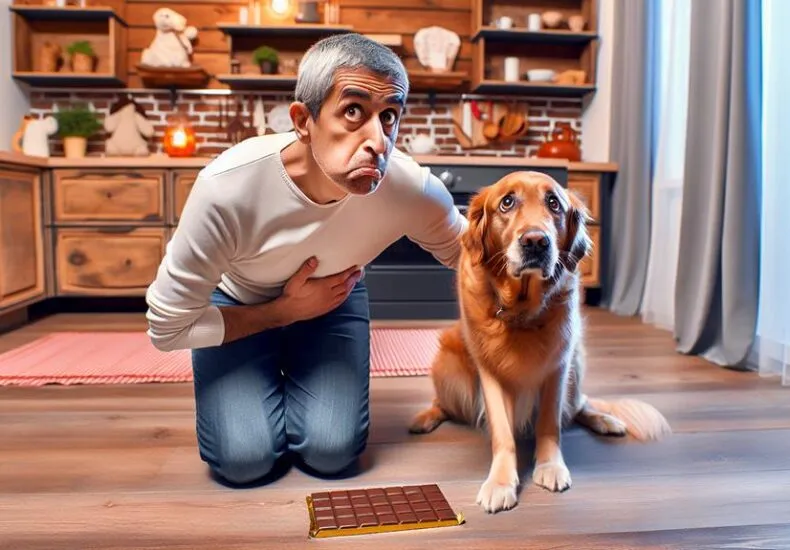
What to Do if My Dog Eats Chocolate
If your dog eats chocolate, it's crucial to stay calm and assess the situation properly. Start by determining the type and amount of chocolate consumed, as well as monitoring for any immediate symptoms like vomiting or Rapid breathing. Next, you'll need to contact your veterinarian, who can guide you based on your dog's weight and the specifics of the chocolate. While you might think you have time, symptoms can develop hours later, and knowing what steps to take next could make all the difference for your furry friend.
Assess the Situation
What should you do first if your dog eats chocolate? The initial step is to assess the situation calmly. Chocolate contains theobromine, which can be toxic to dogs, so recognizing the symptoms early is essential. Symptoms of chocolate ingestion can include vomiting, diarrhea, Rapid breathing, increased heart rate, and restlessness. If you notice any of these signs, it's important to act promptly.
Next, determine how much chocolate your dog consumed and the type of chocolate ingested. While this won't be covered here, it's critical information for your veterinarian. If your dog hasn't shown any symptoms yet, don't assume everything's fine; many signs can take hours to manifest. Monitor your dog closely for any changes in behavior or health.
In terms of emergency response, if your dog displays any concerning symptoms, contact your veterinarian or an emergency animal clinic immediately. Provide them with details about your dog's weight, the type and amount of chocolate consumed, and any observed symptoms. This information will help them assess the severity of the situation and guide you on the next steps.
While waiting for professional help, you can also induce vomiting if advised by your vet. However, don't attempt this without professional guidance, as it can sometimes do more harm than good. Staying calm and acting swiftly can make a significant difference in your dog's outcome, so prioritize their health and safety in this stressful situation.
Determine the Type of Chocolate
How can the type of chocolate your dog ingested impact their health? Understanding the specific type of chocolate is essential, as different varieties contain varying levels of theobromine, the compound responsible for chocolate toxicity in dogs. The more concentrated the chocolate, the greater the risk to your pet's well-being.
Here's a quick reference table to help you identify the types of chocolate and their potential risks:
| Type of Chocolate | Theobromine Content (mg/oz) | Risk Level for Dogs |
|---|---|---|
| White Chocolate | 0.1 | Low |
| Milk Chocolate | 44 | Moderate |
| Dark Chocolate | 150 | High |
| Unsweetened Baking Chocolate | 450 | Very High |
As you can see, dark chocolate and unsweetened baking chocolate pose significant risks due to their high theobromine levels. Even small amounts of dark chocolate can lead to symptoms like vomiting, diarrhea, and increased heart rate. In severe cases, it can cause seizures or even death.
If your dog has ingested chocolate, identifying the type is the first step in evaluating the severity of the situation. This knowledge allows you to act quickly and seek veterinary help if necessary. Always remember, when in doubt, consult your veterinarian for guidance tailored to your dog's specific circumstances. Your prompt action could make a vital difference in ensuring your dog's safety and health.
Calculate the Amount Consumed

If your furry friend has indulged in chocolate, determining the amount consumed is vital for evaluating the potential risk. Chocolate toxicity in dogs is primarily due to two compounds: theobromine and caffeine. The severity of symptoms largely depends on the type and amount of chocolate ingested, as well as your dog's weight.
First, try to estimate the quantity of chocolate your dog ate. Was it a small piece from a candy bar, or did they devour an entire box of chocolates? Weigh the chocolate if possible, and identify the type—dark chocolate contains more theobromine than milk chocolate, making it more toxic.
Next, you can use a chocolate toxicity calculator, which often requires your dog's weight and the amount and type of chocolate eaten. Generally, symptoms of chocolate toxicity can begin to appear within a few hours and may include vomiting, diarrhea, Rapid breathing, increased heart rate, and even seizures in severe cases.
Keep an eye on your dog for any of these symptoms, as they can indicate a serious situation. If your dog has consumed a significant amount or if you're unsure about the severity, it's important to gather this information before seeking further guidance. By calculating the amount of chocolate consumed and understanding the potential risks, you can better assess your next steps and guarantee your dog receives the appropriate care.
Contact a Veterinarian
When faced with the alarming situation of your dog consuming chocolate, reaching out to a veterinarian is essential. Chocolate contains theobromine, a toxic substance for dogs, and the severity of the reaction can depend on the type and amount of chocolate ingested, as well as your dog's size and health status. Prompt veterinary consultation is a critical part of your emergency response.
When you contact the veterinarian, provide them with as much information as possible. This includes the type of chocolate, the estimated amount ingested, and your dog's weight. This information helps them assess the risk and determine the best course of action. If you have the packaging, sharing it can also be beneficial, as it contains specific details about the chocolate's theobromine content.
Your veterinarian may recommend inducing vomiting or administering activated charcoal to minimize absorption of the toxin. In some cases, they might suggest bringing your dog in for further observation or treatment. Remember, pet safety is paramount, and timely intervention can greatly reduce the risk of severe complications.
In situations like this, don't hesitate to ask questions. Understanding the steps your veterinarian plans to take can ease your anxiety and help you make informed decisions. Always keep the contact information of your veterinarian readily available, as quick access to professional advice can make all the difference in ensuring your dog's health and safety.
Monitor Your Dog's Condition

Monitoring your dog's condition after chocolate ingestion is essential for safeguarding their safety and well-being. As a responsible pet owner, you're in the best position to observe any changes in your dog's health. Pay close attention to various symptoms and behavior changes that may arise in the hours following the incident.
Here are three key areas to focus on during your observation:
- Physical Symptoms: Watch for signs like vomiting, diarrhea, or excessive thirst. These can indicate that your dog is reacting negatively to the chocolate.
- behavioral changes: Notice if your dog becomes unusually restless, anxious, or lethargic. Changes in energy levels or mood can be critical indicators of distress.
- Neurological Signs: Be alert for any signs of seizures, tremors, or coordination issues. These symptoms require immediate veterinary attention, as they may indicate severe toxicity.
If you notice any concerning symptoms during your observation, don't hesitate to contact your veterinarian for guidance. It's important to keep in mind that the severity of chocolate toxicity can vary based on the type and amount of chocolate consumed, as well as your dog's size and overall health. By being vigilant and attentive, you can help guarantee that your dog receives the care they need. Remember, your proactive monitoring can make a significant difference in your dog's recovery process.
Frequently Asked Questions
What Symptoms Should I Look for After My Dog Eats Chocolate?
After your dog eats chocolate, look for symptoms like vomiting, diarrhea, increased heart rate, or restlessness. The symptom severity can vary, so it's essential to take preventive measures and consult a veterinarian immediately.
How Long Does Chocolate Toxicity Last in Dogs?
Chocolate toxicity duration in dogs varies, often lasting from 24 to 72 hours. As your dog's body struggles with chocolate metabolism, watch for symptoms and seek veterinary help if they persist or worsen.
Can Small Amounts of Chocolate Be Safe for Dogs?
Small amounts of chocolate can be harmful, depending on chocolate types and your dog's weight. Even a little can lead to toxicity, so it's best to avoid giving chocolate to your dog altogether.
Are Certain Dog Breeds More Sensitive to Chocolate?
Certain dog breeds, like Toy breeds, can be more sensitive to chocolate due to their size and metabolic differences. Dark chocolate types contain higher theobromine levels, increasing risk for those sensitive breeds considerably. Always monitor closely.
What Home Remedies Can I Use if My Dog Eats Chocolate?
If your dog eats chocolate, first assess the situation. Emergency steps include inducing vomiting and contacting a vet. Always prioritize dog care by keeping chocolate away, and educating yourself on safe food items for your pet.
Conclusion
In the event your dog eats chocolate, remember that swift action is essential, like a lighthouse guiding a ship through a storm. By evaluating the situation, determining the type and amount of chocolate, and contacting your veterinarian, you're taking important steps to safeguard your furry friend's health. Keep a watchful eye on their condition, as symptoms can be delayed. Your prompt response can be the difference between a scare and a safe recovery.
You may also like
Archives
Calendar
| M | T | W | T | F | S | S |
|---|---|---|---|---|---|---|
| 1 | 2 | 3 | 4 | 5 | 6 | |
| 7 | 8 | 9 | 10 | 11 | 12 | 13 |
| 14 | 15 | 16 | 17 | 18 | 19 | 20 |
| 21 | 22 | 23 | 24 | 25 | 26 | 27 |
| 28 | 29 | 30 | ||||
Leave a Reply